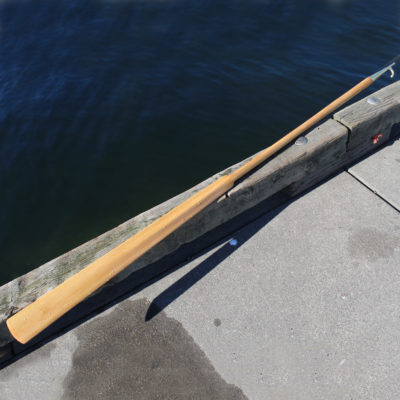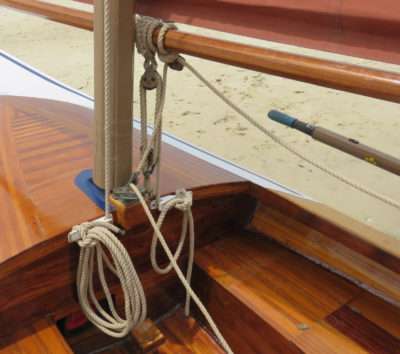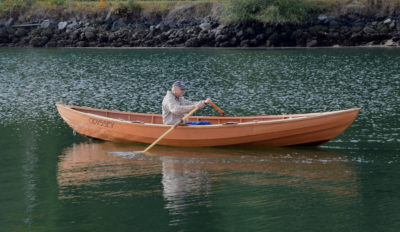Cooking at anchor aboard a small sail-and-oar boat can be a challenge. Some make dedicated boxes to hold their stove, fuel, and cooking utensils, and while they may be convenient, finding a place to stow them can be difficult, especially in a boat already crowded with gear for a long trip. In my boat, FIRE-DRAKE, my critical gear goes through 9″-diameter hatches into the watertight compartments, so a galley box is out.
 photo and video by the author
photo and video by the authorWith the pot locked on the stove and a folding tripod base clipped to the fuel tank, the Jetboil system behaves itself while cooking at anchor with the boat rocking.
Jetboil’s Flash Cooking System is pot, stove, and fuel all in one tidy package that stows easily. Since acquiring mine a couple of years ago, I use it for 99 percent of my cooking. It is very quick to boil water and simmers well enough for the meals I make with it. My cooked meals are generally simple: porridge in the morning and dried pasta or rice for the evening meal, with soup occasionally.
The pot is a 1-liter aluminum cylinder with nonstick coating and a base that connects it to the burner. It has a neoprene insulating sleeve to retain heat and a webbing handle so you don’t need a pot gripper. Welded to the bottom of the can is a corrugated aluminum heat exchanger that greatly increases the efficiency of the heat transfer from the flame to the pot, so much so that the flame doesn’t melt the neoprene. The burner has a built-in piezoelectric lighter; its isobutane fuel canisters are available in 100g, 230g, and 450g. The insulating sleeve has a window with an indicator that changes color as the water comes to a boil. It works, but you can hear when the water boils.
Disassembled, the stand, burner, and a 100g fuel canister all fit neatly inside the pot, kept in by a silicone lid. There is also a plastic measuring cup that fits on the bottom to protect the burner.
Assembled, it looks a little unstable, but having the stove and pot connected make cooking much less precarious, and a fold-out base with sticky feet, snapped to the fuel canister, steadies the stove. If you fill the Jetboil to no more than the recommended fill line (500ml, or 2 cups) it seems to be adequate for the normal motion of an anchored boat. I did accidentally kick mine once and partially knock it over, but that is a risk with any stove used in confined quarters.
It only takes about 50 seconds to assemble the stove and get the flame lit. Then in just over 3 minutes, 2 cups of water will come to a boil.
For most of my meals I boil the water, add the ingredients, partially cook it at reduced heat, then shut the stove down, put an additional stove insulating cap (made for another stove but it fits the Jetboil Flash nicely) over the top, and let it finish cooking. The method saves fuel, and the extra insulation keeps the food hotter. By turning the stove off before cooking is complete, a 100g canister will last about a week.
Should you want to cook anything in a pan, Jetboil makes a pot support that fits on the burner assembly.
I’ve used the Jetboil Flash for over 80 cruising days now, and it has performed flawlessly every time.![]()
Alex Zimmerman is a semi-retired mechanical technologist and former executive. His first boat was an abandoned Chestnut canoe that he fixed up as a teenager and paddled on the waterways of eastern Manitoba and northwestern Ontario. He started his professional career as a maritime engineer in the Canadian Navy, and that triggered his interest in sailing. He didn’t get back into boatbuilding until he moved back to Vancouver Island in the ’90s, where he built a number of sea kayaks that he used to explore the coast. He built his first sail-and-oar boat in the early 2000s and completed his most recent one in 2016. He says he can stop building boats anytime.
The Flash Cooking System is available from Jetboil for $99.99 and from many outdoor retailers.
Is there a product that might be useful for boatbuilding, cruising or shore-side camping that you’d like us to review? Please email your suggestions.












I’ve made stabilized stoves like this by cutting a hole in a bit of wood that matches the diameter of the fuel canister or the stove (an old Svea) then spring-clamping the board to a thwart.